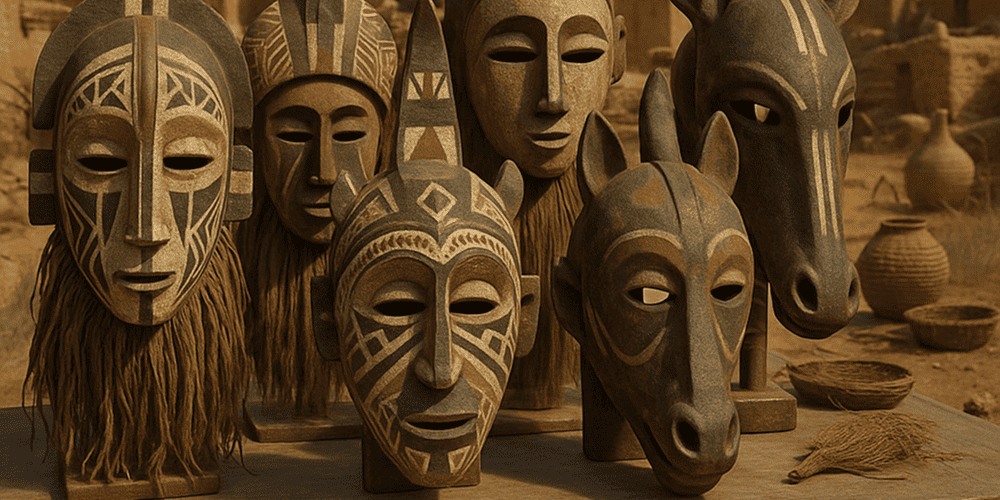Dogon Tribe Masks are among the most visually striking and culturally important artifacts in West African art. Created by the Dogon people of Mali, these masks are renowned for their variety, symbolic complexity, and dramatic forms. Characterized by geometric shapes, elongated faces, minimalistic features, and sometimes towering superstructures, Dogon masks often display bold patterns and natural pigments. While each mask type is distinct, they share a powerful presence and are deeply tied to ritual, social life, and the spiritual beliefs of the Dogon. Emerging as early as the 14th century, Dogon masks continue to captivate scholars, collectors, and art lovers worldwide.
Historical Origins: The Roots of Dogon Tribe Masks
The history of Dogon Tribe Masks is interwoven with the migration, settlement, and spiritual development of the Dogon people. The term “Dogon” refers to both the ethnic group and the region they inhabit — the rocky Bandiagara Escarpment in central Mali. The masks themselves are known by various names in the Dogon language, such as “wana” (mask) and “damana” (referring to specific mask types).
Historically, Dogon masks are believed to have originated as part of the Dama funerary rites, which date back to at least the 14th–15th centuries. The Dama is a collective ceremony to honor the deceased, facilitate the transition of spirits to the afterlife, and restore harmony between the living and the ancestral world. Over centuries, the design and use of Dogon masks evolved, with influences from neighboring cultures and internal innovations. Artifacts, including ancient wooden masks and rock art, attest to the long-standing tradition and its importance in Dogon society.
Cultural Significance and Symbolism of Dogon Tribe Masks
Dogon Tribe Masks hold profound symbolic meaning within Dogon cosmology and social order. Each mask type represents a specific spirit, ancestor, animal, or mythical being, and their performances are believed to mediate between the earthly and spiritual realms. The most famous mask, the Kanaga, features a double-barred cross and symbolizes the connection between heaven and earth. Other masks, such as the Sirige (towering vertical masks) and Satimbe (female ancestor masks), each embody unique mythological and social narratives.
Spiritually, masks play a central role in rituals that mark death, fertility, harvest, and social cohesion. They are also tied to Dogon creation myths — most notably those involving the Nommo, primordial beings sent by the creator god Amma. Socially, only initiated members of the Awa society (a secret mask society) may carve, wear, or dance with the masks, underscoring their sacred and exclusive nature.
Materials and Craftsmanship: Creating Dogon Tribe Masks
Dogon mask-making is a highly skilled craft passed down through generations. Traditional Dogon Tribe Masks are carved from local woods, such as kapok or acacia. Tools include adzes, knives, and chisels. Once the basic form is shaped, the mask is often decorated with natural pigments derived from clay, charcoal, and plants. Some masks are adorned with fiber, cowrie shells, or metal inlays for added texture and symbolism.

The process is deeply ritualized: mask-makers may observe taboos, offer prayers, or undergo purification before beginning their work. Regional differences exist, with northern Dogon masks tending to be more angular and abstract, while southern examples are sometimes more naturalistic. Color symbolism is crucial — white signifies purity or death, red denotes life or power, and black is associated with the unknown or the spirit world.
Ritual Functions and Contemporary Uses of Dogon Tribe Masks
Dogon masks are primarily used in ritual and ceremonial contexts. The most important event is the Dama, where dozens of masked dancers perform complex choreographies to guide souls to the afterlife and ensure cosmic balance. Masks are also used during the Sigui festival (held every 60 years), agricultural celebrations, and rites of passage.
While Dogon masks were traditionally not used in theatrical performances as in other African cultures, their dances are highly dramatic and symbolic. Over time, the role of the mask has expanded — today, they are sometimes performed for tourists or in national festivals, though sacred uses remain separate and strictly controlled.
Regional Variations: Diversity Among Dogon Tribe Masks
Within the Dogon region, mask types and styles vary widely. The Kanaga mask, with its double cross, is ubiquitous, but other forms include:
- Sirige Mask: Tall, plank-like, with intricate geometric patterns, used in funerary dances.
- Satimbe Mask: Represents the mythic ancestor Yasigi, the only woman allowed to enter the Awa society.
- Walu Mask: Resembles an antelope, symbolizing agriculture and fertility.
- Monkey Mask (Dege): Used to parody or critique social behavior.
Neighboring cultures, such as the Bamana and Bozo, have influenced Dogon mask forms, but Dogon masks remain distinctive for their abstraction, verticality, and cosmological symbolism.
Notable Examples and Collections: Where to See Dogon Tribe Masks
Dogon Tribe Masks are featured in major museum collections around the world. Notable examples can be found at:
- The Musée du Quai Branly (Paris)
- The Metropolitan Museum of Art (New York)
- The British Museum (London)
- The National Museum of Mali (Bamako)
- The Smithsonian National Museum of African Art (Washington, D.C.)
Important historical masks have been uncovered in Dogon villages and during archaeological expeditions, some of which are now held in private collections and highlighted by specialized sites like toddmasks.com. These collections offer invaluable insights into the evolution, diversity, and enduring artistry of Dogon mask-making.
Artistic and Cultural Influence of Dogon Tribe Masks
The bold forms and spiritual power of Dogon Tribe Masks have had a significant impact on global art. Modern artists, including Pablo Picasso and the Cubists, drew inspiration from the abstraction and geometry of Dogon masks. In literature and film, Dogon masks have appeared as symbols of African heritage, mystery, and transformation. Contemporary designers and fashion houses occasionally reference Dogon motifs in textiles and jewelry, reflecting the masks’ continued relevance and adaptability.

Dogon masks play a vital role in preserving and sharing Africa’s cultural heritage, serving as ambassadors of Dogon philosophy, aesthetics, and spirituality.
Contemporary Status and Preservation of Dogon Tribe Masks
Today, the tradition of Dogon mask-making is preserved by master carvers and members of the Awa society. Efforts to safeguard the craft include community-led workshops, government-supported cultural centers, and international collaborations. Some artists experiment with new forms and materials, while others work to document and teach the authentic techniques.
Educational initiatives and festivals in Mali help transmit mask traditions to younger generations. Organizations and online platforms, such as toddmasks.com, support awareness and appreciation, ensuring the survival and evolution of Dogon mask culture in a rapidly changing world.
Collecting and Acquisition: The Dogon Mask Market
The market for Dogon Tribe Masks ranges from authentic ritual pieces to contemporary art and tourist souvenirs. Genuine ritual masks, especially those with provenance and age, are highly valued by collectors and institutions. Prices depend on age, rarity, condition, and documented history. Authentic pieces are best acquired through reputable dealers, museum shops, or direct contact with Dogon communities, always respecting ethical considerations. As with many West African Masks, understanding the cultural context and origins of Dogon pieces is essential for ethical collecting and appreciation.
